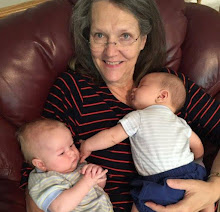
Great Great Grandmother Elizabeth Ann DAVIS PARKER
about 1910
Additional stories about
Elizabeth Ann DAVIS PARKER
By Sophia PARKER STAPLEY - daughter of Elizabeth Ann DAVIS and Charles PARKER
Elizabeth always knit wool stockings and socks for each member of the family. Everything she made was very neat. When she got too crippled, father bought her a knitting machine, the only one in town. This was a real treat for Mother. Now she could knit a sock in a day at least. It took longer to thread the machine than knit the stocking! Charles bought Elizabeth the first range stove in the town. They also owned the first electric washing machine in Kanarra. She never did own an electric sewing machine but she wore out two treading-sewing machines.
Our family dog, named Rover, was very thoughtful of Mother. When the [grand] children would scuffle in their play, Rover would go stand over Mother’s feet to protect them from being trampled on. They were so tender she hated to have anything come near them, and believe me Rover knew this. Rover would round-up the horses or cattle when he saw Charles going after them. When the daughters and sons came home with their families, rover showed as much glee as any person. He lived to be very old and was a real friend to every member of the family. There was another dog the family had a short time, that would take a bucket of water out of Mother’s hand when he would see her try to carry it in the house and do it for her! They had to dip water from the barrel or spring in those days, for household purposes. It was hard work.
I well remember the wedding receptions father and mother gave to most of their children. They would invite all the people who were adults, from the age of 14 years up, who lived in the community. The crowd would range from 150 to 200 people. The dinner spread was exquisite: places carefully set; table decorations; and all the delicious food cooked by members of the Parker family. There would be three or four varieties of meat, hot potatoes and gravy, several kinds of vegetable, three or four varieties of pies and cakes, with other deserts such as puddings. There was always a large wedding cake, and a highly-decorated bridegroom cake that stood about 18 inches high. The bride’s cake was a white cake and the bridegroom cake was a dark fruit-cake. Everybody had a piece of these cakes, which were very special. After dinner, sweet wines were served to the ladies, a very choice brandy and sweet Dixie wine served to the gentlemen, if people so desired. People brought wedding gifts to the couple. Then that evening a free dance would be given to the public in the community dance hall. The dance orchestra consisted of a violin, guitars, piano, and often a horn or two. An enjoyable day and night for everyone.
The last story I would like to leave you with has to do with their loyalty and patriotism. Charles and Elizabeth often told their children of their love and appreciation fro having been born and privileged to live in the United States of America. They felt extremely blessed for the necessities of life which were stored in the cellar, barns and elsewhere. Although this was the case, I recall that during the First World War their household observed meatless, wheatless, and sugarless days as requested by their Country. Their love for the Stars and Stripes I shall never forget. The flag was hoisted up the Liberty Pole in Kanarra three times a year -- July Fourth, July Twenty-fourth, and election Day and would remain on the Pole for two or three weeks at a time. The flag was whipped by the wind until the end was torn into ribbons. But it was still used in this way. I remember one year the flag was used and was finally in shreds. The town had needed a mew one for some time. Charles, with his own money went to the store and bought the very best of cotton material for a new large flag: and Elizabeth, though she was crippled and her hands and fingers twisted out of shape by arthritis -- having a difficult time using the needle and sewing machine without a lot of pain -- made every stitch in this flag. and an artistic piece of hand and machine work it was! When it was finished she and Charles presented it to the community. This flag was used for many years and was still bright and beautiful the last I knew.
Mother died on February 26, 1927. On every Decoration Day and Fourth of July, Charles would place a flag on her grave. One of his nieces, Juanita Davies, once asked him why he placed a flag on her grave. Charles answered her, “If any soldier lying in the graves of this cemetery is deserving of decorating in this way, Elizabeth is one of the bravest.” He then related to Juanita how Elizabeth had made every stitch in the large flag which flew on the Liberty Pole on every patriotic occasion. Charles continued this tribute to his wife, as long as he was able to visit the cemetery.
Two beautiful parents and we loved them dearly!
(Together Again An Autobiographical History, sophia Parker Stapley, pp 102-104)
[click on label DAVIS Elizabeth Ann to see family photos]


No comments:
Post a Comment